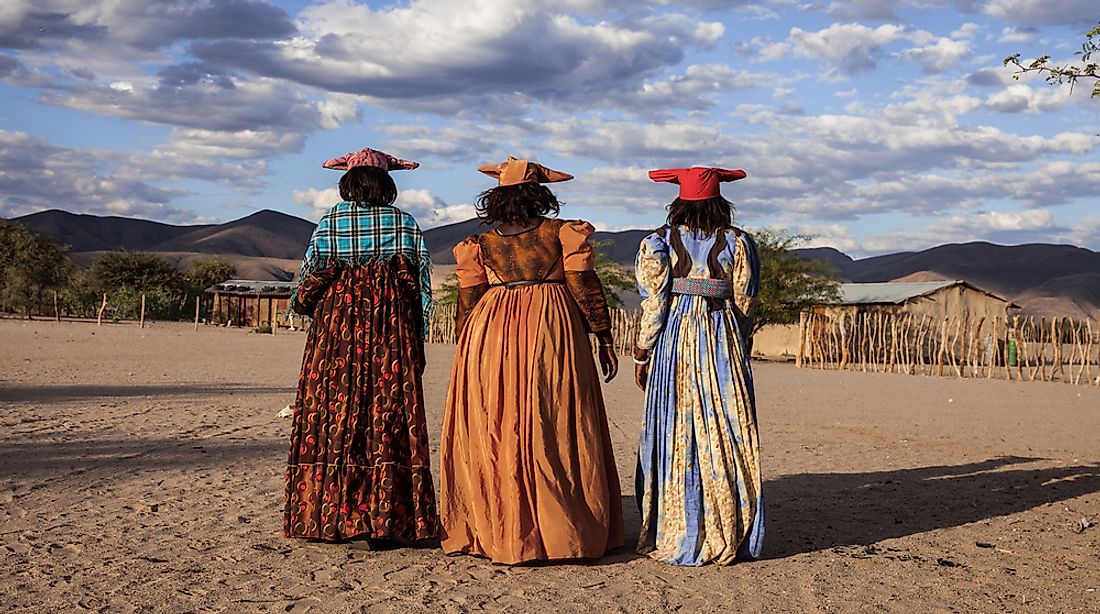Ethnic Groups Of Namibia

This African country was founded in 1990 after it won independence from South Africa. The population density is the second lowest in the world, meaning that residents have significant land area per person. Humans have inhabited the area since ancient times and Bantu- speaking tribes began arriving in the 14th century AD. German colonizers began developing agriculture and infrastructure in the region during the 1800’s until 1915 when South Africa took over its administration. The current population of Namibia is 2.1 million, and this is made up of several different tribes and ethnic groups which are discussed below.
Tribes and Ethnicities of Namibia
Ovambo People
About half of the population is made up of the Ovambo people (also known as Ambo) who mainly inhabit the northern part of the country. The Ovambo group consists of approximately 12 smaller tribes and is part of the larger Bantu people. Traditionally, this ethnic group has lived under the guidance of a chief who assigned plots of land to each family. When the tenant died, the chief assigned the land to a new person. Today, the people survive by harvesting millet (a type of grain) and raising livestock. The most common religion is the Lutheran faith although it is mixed with traditional beliefs in good and bad spirits.
Kavango People
Following the Ovambo people is the Kavango which makes up 9% of the total population. This ethnic group is also a Bantu group, and they live along the northeastern region of Namibia. They practice fishing, livestock raising, and agricultural harvesting for subsistence. Namibian law protects their right to practice their traditional government which divides the group into five kingdoms each ruled by a separate king. Their customs place a lot of respect towards elders.
White Namibian
White Namibians consist of individuals of German, British, Portuguese, and Afrikaner descent. They are estimated to make up 7% of the population although accuracy is limited because the Namibian government no longer collects racial data on the census. The majority of these people live in the urban centers. During the apartheid regime, which racially segregated the area and gave political power to the white minority, this group gained a privileged status that continues to benefit them today. They own 50% of all farmable land despite a land reform that has tried to return control of the property to its original owners.
Damara People
The Damara people comprise 7% of the population and live in the northwestern part of the country. Their native language is Khoekhoe though little else is known about the group. They have no relationship with other tribes and are believed to have descended from a tribe of hunter-gatherers. They once practiced coppersmithing, herding, and agricultural in the central part of the country. Their belief in communally owned property ultimately led to them being forced out of the territory by the Herero and Nama tribes who they went on to work for as house servants.
Herero Group
Another 7% of the total population is made up of the Herero group that has historically inhabited the central part of the country for its vast pastureland. This geographic separation meant that the Herero did not have much interaction with the previously mentioned Ovambo and Kavango people. This group is originally from the eastern part of the continent in the 17th and 18th centuries. They were soon followed by the Nama (which make up 5% of the population) and colonialists.
The Nama and Herero began wars with each other that lasted throughout the 19th century although they were able to find common ground over their distrust of the German colonizers. The white immigrants seized land from both the Herero and Nama and had majority control by the beginning of the 1900’s. This did not, however, appease the Germans, and they had plans to displace the tribes to reservation lands to obtain more land and cattle. The two tribal groups worked together to form a rebellion that lasted for three years and nearly obliterated the Herero and Nama populations. Estimates believe approximately 80% of each tribe perished during the genocide. Those that remained were pushed out to desert land and forced to live in concentration camps along the coast and work as slaves building the railways and mining diamonds.
Minority Groups
Other tribes and ethnicities live in Namibia though they make up a small percentage of the population. These include the: Caprivian (4%), Busmen (3%), Tswana (1%), and other groups that make up less than 1% each.
Tribes And Ethnic Groups Of Namibia
| Rank | Tribe or Ethnicity | Share of Namibian Population |
|---|---|---|
| 1 | Ovambo | 50% |
| 2 | Kavango | 9% |
| 3 | White Namibian | 7% |
| 4 | Herero | 7% |
| 5 | Damara | 7% |
| 6 | Nama | 5% |
| 7 | Caprivian | 4% |
| 8 | Busmen | 3% |
| 9 | Tswana | 1% |
| 10 | Others | Less than 1% each |











